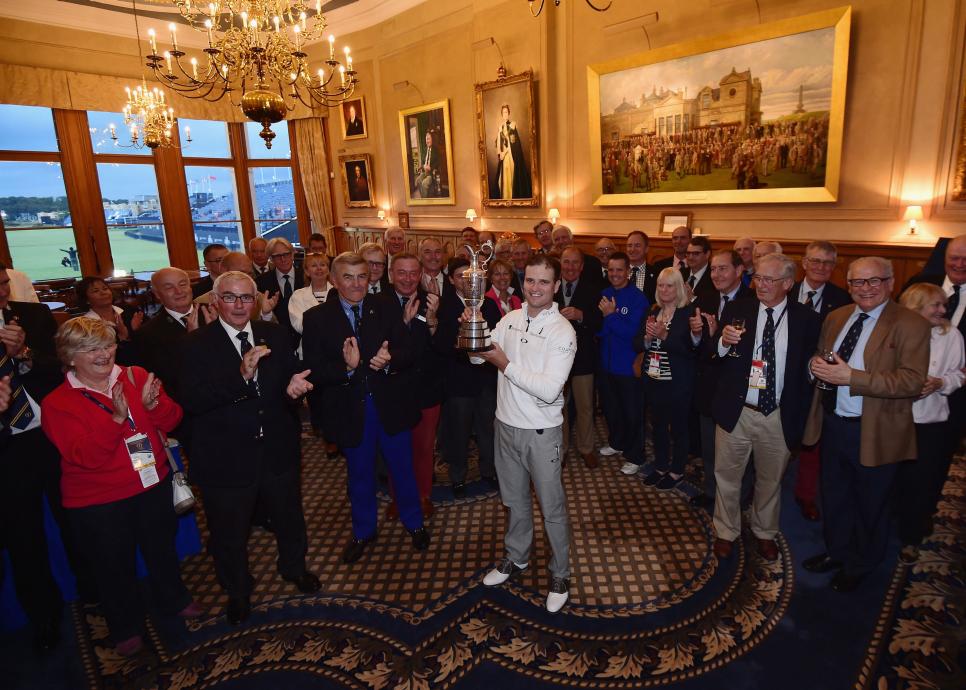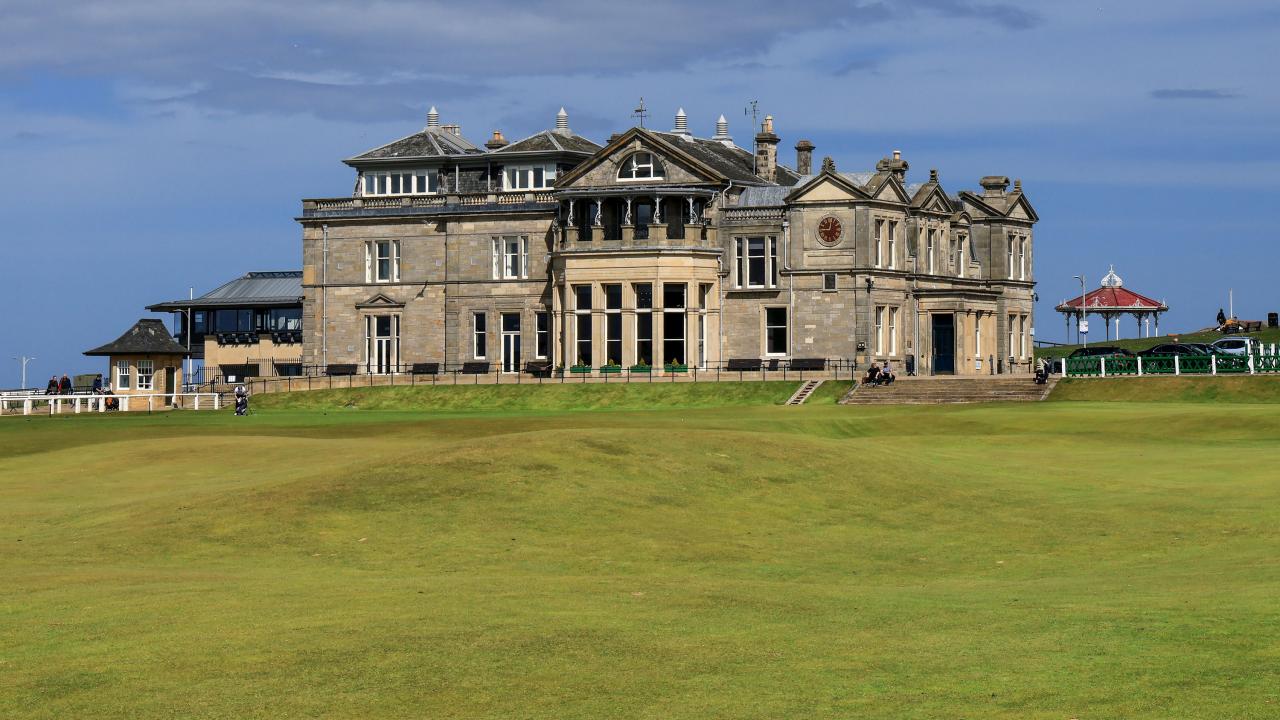David Cannon
By John Huggan
ST. ANDREWS, Scotland — It is, no question, one of the most recognisable edifices in any sport. And surely the most recognisable building in all of golf. Since 1854, the clubhouse of the Royal & Ancient Golf Club has sat directly behind the first tee on the Old Course at St. Andrews, the most famous 18 holes in any land. Not a bad spot really.
Hang on though. Only the outside of this esteemed establishment is really familiar to the vast majority. For most of us, what lies inside remains something of a mystery. Routinely, only the 2,500 or so worldwide R&A members and their guests are permitted entry through the side door on the right as you look at the building from the course. That fact is true 364 days of any non-leap year. On one day, however, November 30 or St. Andrews Day, the clubhouse is open to members of the public interested enough to take a tour of the premises.
I am, so I did. In the company of clubhouse manager Graham Clark, I spent a fascinating half-hour looking around the various rooms on the ground floor. Only the ground floor. What lies above and below is still reserved for members, no matter what the calendar says.
Standing in the foyer in front of the porter’s desk, my eyes were immediately drawn to the silverware cabinet a few feet away. In it, alongside the likes of the Amateur Championship trophy and the Ladies Amateur Championship trophy sits the original claret jug. Last presented to the winner of the Open Championship in 1927—a young lad by the name of Bobby Jones—this priceless artefact never leaves the clubhouse.
Indeed, according to Clark, Jones himself must take some credit for that fact. It seems that the thought of something happening to the jug as it sailed back and forth across the Atlantic was just too stressful for the man who would go on to win the Grand Slam in 1930. By that time, a replica trophy was given to the “champion golfer of the year.”
One last thing, which will no doubt appeal to fans of quirk: the famous spelling mistake on the trophy used today—“Holylake” instead of “Hoylake” as the 1947 venue—is not one repeated from the original jug. Rightly and properly, on there, “Hoylake” is present and correct.
Next stop, only a few yards to the left, is the Trophy Room, or the South Room (no one will ever accuse the R&A of being overly imaginative in their naming of rooms within the clubhouse). In there sit the various medals and cups played for by the members at the Spring and Autumn Meetings. Most famous among an eclectic mix that includes a Kangaroo Paw (which doubles as a cigar lighter) and a Canadian Silver Beaver, are the club captain’s balls. All the way back to 1754, every captain has hit a ceremonial drive off the first tee, had the ball returned by a local caddie, then had said ball enshrined in a silver casing. They’re not all silver though; captains of royal birth have golden balls.
Next stop was the Big Room, in which we found the largest single-piece carpet in Scotland. Hand-made by the now-defunct Antrim Carpets in Ireland, it weighs just under half a ton. Originally home to the member’s lockers, this is the most visible room in the clubhouse—the large bay windows look out over the first and 18th fairways—and still plays host to a few sets of clubs. But only a select few—traditionally the longest-standing members—have that privilege.
Still, it is the various paintings to which the eyes are drawn. Queen Elizabeth is up there. As is her uncle, the Duke of Windsor. So is Sir Michael Bonallack, five-time Amateur champion and a past captain and secretary of the club (he and Lizzy Windsor have the honour of being the only two living people on the walls).

David Cannon/R&A
Zach Johnson showed off the claret jug in the “Big Room” inside the Royal & Ancient clubhouse when he won the Open in 2015.
Former Open champion Willie Park of Musselburgh is there too, but is making a guest appearance, replacing Freddie Tait, who is out on loan. Perhaps the most memorable image, however, is the portrayal of the first driving-in ceremony. Financed by every member in the frame (of which there are many), the trick, according to Clark, is to count how many dogs are in the picture (six, apparently).
“You can tell all the pictures that show a time before 1899,” says Clark. “No balcony on the front of the clubhouse.”
The Big Room is also home to what amounts to the club’s vetting service. Once a prospective member is accepted by the Club Committee, his name goes in “the book” and members are invited to support his application. Each prospective member will need somewhere between 30 to 40 members to support him if his application is to be accepted. It is, however, possible to be “blackballed.” Members are free to write letters contesting the eligibility of any candidate. If two or three members object, the candidate will need 40 to 50 supporters to get in. If more than three members object, it is unlikely that candidate will be considered.
Interestingly, the clubhouse has no bar. Members wishing a drink can get the attention of a waiter or waitress or ring one of the many bells situated in the Big Room and elsewhere. And the food? The club has a deserved reputation for the high quality of its lunches (served upstairs in the dining room). Local fish and chips are always popular, as is the surely unique house specialty of mince and poached egg—a curious mix, even in the land that gave the world the haggis.
Equipment connoisseurs are not neglected on this tour. In the corridor that leads to the library, a wall cabinet contains clubs and balls that represent a graphic history of development in both. There are some classic clubs: the “water niblick,” another with adjustable lofts, and a “roller putter,” to name but three.
In the library, which, disappointingly, it is far from extensive, hangs a map of the Old Course. That is not always the case. As the club owns more pictures than it has space for, the staff routinely make changes.
Next door, we found ourselves in the snooker room, a full-size table dominating the proceedings. It sees regular use, according to Clark, in what used to be the committee room. In fact, there used to be two tables, one for members, the other for staff who, until the 1950s, lived in the clubhouse. The female staff even had their own staircase to their quarters in what became a two-story structure in 1882.
Today then, as it has always done, the clubhouse continues to evolve. For example, should plans for new locker rooms go ahead, they will be located under the small car park that sits alongside this fascinating building. All in all, a must-visit for golf geeks everywhere.









